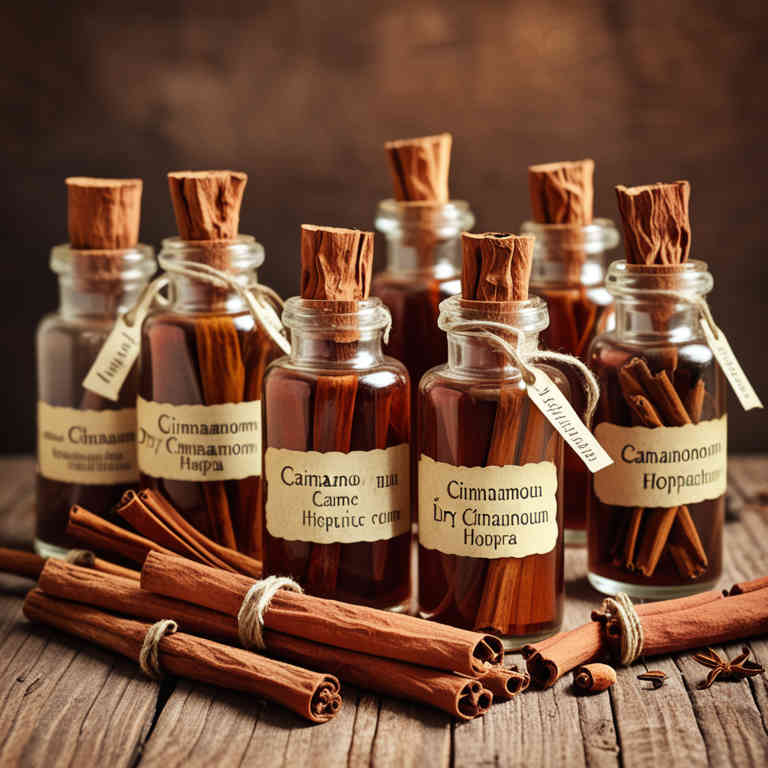10 Best Cinnamomum Camphora Preparations

The best medicinal preparations of Cinnamomum camphora are essential oils, teas, tinctures, oils, and decoctions, each offering unique therapeutic benefits.
Essential oils derived from the plant are commonly used for their calming and anti-inflammatory properties.
Teas made from dried leaves or bark can aid digestion and relieve respiratory discomfort.
Tinctures provide a concentrated form of the herb’s active compounds for targeted use.
Decoctions, made by simmering the bark or roots, are valued for their ability to support muscle relaxation and pain relief.
Below there's a list of the 10 best herbal preparations of cinnamomum camphora for medicinal purposes.
2. Teas
Cinnamomum camphora teas is commonly used to relieve symptoms of respiratory conditions, digestive issues, and muscle pain.
This herbal preparation is often employed to treat ailments such as coughs, colds, nausea, and inflammation. The most common medicinal uses include alleviating respiratory congestion, soothing gastrointestinal discomfort, and reducing muscle soreness. The bioactive constituents responsible for these effects include camphor, cineole, and cinnamaldehyde, which possess anti-inflammatory, antispasmodic, and analgesic properties.
These compounds work together to provide the therapeutic benefits associated with Cinnamomum camphora teas.

3. Tinctures
Cinnamomum camphora tinctures is commonly used to treat respiratory and muscular ailments, as well as for their soothing and antiseptic properties.
These tinctures are often employed to alleviate symptoms of colds, coughs, bronchitis, and muscle pain. They are also used in topical applications to relieve inflammation and itching. The bioactive constituents responsible for these effects include camphor, cinnamaldehyde, eucalyptol, and other essential oils that have antimicrobial, analgesic, and anti-inflammatory properties.
These compounds work synergistically to provide the therapeutic benefits associated with Cinnamomum camphora tinctures.

4. Oils
Cinnamomum camphora oils is commonly used to treat respiratory infections, muscle pain, and skin conditions due to its antiseptic, anti-inflammatory, and analgesic properties.
These oils are frequently applied in aromatherapy, topical treatments, and as an ingredient in medicinal balms. The most common ailments addressed include colds, coughs, rheumatic pain, and minor skin irritations. The bioactive constituents responsible for these effects include camphor, cineole, and alpha-pinene, which possess antimicrobial, anti-inflammatory, and soothing properties.
These compounds work synergistically to provide the therapeutic benefits associated with Cinnamomum camphora oils.

5. Decoctions
Cinnamomum camphora decoctions is commonly used to treat respiratory and digestive disorders, as well as to relieve pain and inflammation.
These decoctions are often employed in traditional medicine to alleviate symptoms of colds, coughs, bronchitis, and gastrointestinal issues like indigestion and nausea. They are also used to reduce fever and promote circulation. The bioactive constituents responsible for these effects include essential oils such as camphor, cineole, and linalool, which possess antimicrobial, anti-inflammatory, and analgesic properties.
Additionally, compounds like flavonoids and tannins contribute to its therapeutic benefits by supporting immune function and digestive health.

6. Syrups
Cinnamomum camphora syrups is commonly used to relieve symptoms of respiratory and digestive disorders, as well as to alleviate pain and inflammation.
These syrups are often employed to treat coughs, bronchitis, asthma, and gastrointestinal issues such as indigestion and nausea. The bioactive constituents responsible for its medicinal properties include essential oils like camphor, cineole, and linalool, which possess antiseptic, anti-inflammatory, and analgesic effects. Additionally, the presence of flavonoids and tannins contributes to its ability to soothe mucous membranes and reduce irritation.
This herbal preparation has been traditionally used in Chinese medicine for its broad-spectrum therapeutic benefits.

7. Capsules
Cinnamomum camphora capsules is commonly used to treat respiratory conditions, digestive issues, and skin infections due to its anti-inflammatory and antimicrobial properties.
These capsules are often employed for ailments such as coughs, bronchitis, indigestion, and eczema. The bioactive constituents responsible for these effects include camphor, cineole, and alpha-pinene, which exhibit antiseptic, analgesic, and expectorant actions. Additionally, the essential oils in the capsules may help relieve muscle pain and reduce fever.
This herbal preparation has been traditionally used in Chinese medicine for its soothing and healing effects on the body.

8. Liniments
Cinnamomum camphora liniments is commonly used to relieve pain, reduce inflammation, and treat skin conditions.
These liniments are frequently applied topically for ailments such as muscle aches, arthritis, sprains, and minor skin irritations. The most common medicinal uses include alleviating pain from injuries, reducing swelling, and providing a soothing effect on the skin. The bioactive constituents responsible for these effects include camphor, cineole, and alpha-pinene, which have antiseptic, analgesic, and anti-inflammatory properties.
These compounds work together to provide the therapeutic benefits associated with Cinnamomum camphora liniments.

9. Creams
Cinnamomum camphora creams is commonly used to relieve pain, reduce inflammation, and treat skin conditions such as eczema and psoriasis.
These creams are often applied topically to alleviate symptoms of arthritis, muscle aches, and headaches. The most common medicinal uses include treating rheumatic pain, skin irritations, and minor burns. The bioactive constituents responsible for these effects include camphor, menthol, eucalyptol, and various essential oils that have analgesic, anti-inflammatory, and antimicrobial properties.
These compounds work together to provide soothing and therapeutic benefits to the skin and underlying tissues.

10. Linctuses
Cinnamomum camphora linctuses is commonly used to treat respiratory conditions such as coughs, bronchitis, and asthma due to its expectorant and soothing properties.
The preparation is often employed to alleviate symptoms of colds, sore throats, and other upper respiratory tract infections. It is also used in traditional medicine to relieve muscle pain and inflammation. The bioactive constituents responsible for its medicinal effects include camphor, cineole, and various essential oils that possess antispasmodic, analgesic, and anti-inflammatory properties.
These compounds work synergistically to provide relief from respiratory and muscular discomfort.
